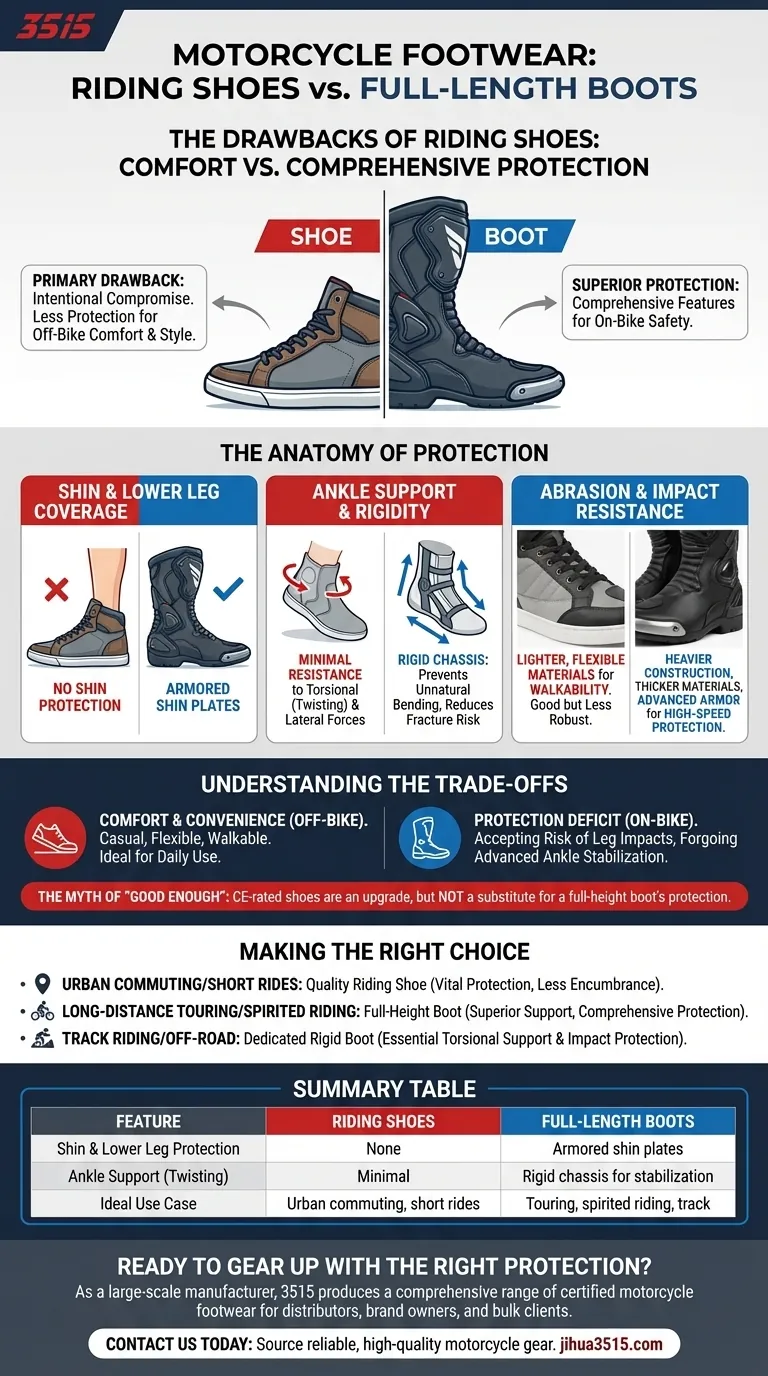The primary drawback of motorcycle riding shoes is a direct and intentional compromise in protection for the sake of off-bike comfort and style. They lack the comprehensive safety features of full-length boots, specifically offering no shin protection and significantly less support against the common twisting injuries that occur in an accident.
Choosing riding shoes over boots is a conscious decision to trade a higher level of on-bike protection for superior off-bike comfort and walkability. Understanding precisely what protection you are giving up is critical to making a safe choice for your riding style.

The Anatomy of Protection: Shoes vs. Boots
To understand the drawbacks, you must first understand how proper motorcycle footwear is designed to prevent injury. The differences between a riding shoe and a boot are most apparent in three critical areas.
Shin and Lower Leg Coverage
A defining feature of a riding shoe is that its coverage ends at or just above the ankle. This leaves the entire shin and lower leg completely exposed.
Full-length boots, by contrast, extend up the calf and incorporate armored shin plates. This component is crucial for shielding you from direct impacts with road hazards, debris, or the motorcycle itself during a crash.
Ankle Support and Rigidity
This is arguably the most significant functional difference. Ankle injuries in motorcycle accidents are often caused by torsional (twisting) and lateral (side-to-side) forces.
Riding shoes typically feature reinforced ankle cups for impact protection, but their flexible construction offers minimal resistance to these twisting forces.
A dedicated boot is engineered with a rigid chassis. This structure is designed to allow normal forward-and-back foot movement for shifting and braking while actively preventing the ankle from bending or twisting in unnatural directions, drastically reducing the risk of complex fractures and ligament damage.
Abrasion and Impact Resistance
While certified riding shoes are made with abrasion-resistant materials, they are often designed to be lighter and more flexible for walkability.
Touring or track boots frequently use thicker leather, more extensive hard armor, and advanced composite materials. This heavier construction provides a higher degree of both slide protection and impact energy absorption, making them better suited for high-speed scenarios.
Understanding the Trade-offs
Choosing between shoes and boots is not a matter of one being "good" and the other "bad." It is about acknowledging the inherent compromises and aligning your gear with your risk level.
The Comfort & Convenience Factor
There is no debate that riding shoes are superior for daily use. Their casual appearance, flexibility, and light weight make them ideal for riders who need to walk comfortably at their destination without changing footwear. This convenience is their primary selling point.
The Protection Deficit
That convenience comes at a price. By choosing a shoe, you are accepting the risk of shin and lower-leg impacts. More importantly, you are forgoing the advanced ankle stabilization that is a core safety feature of a true motorcycle boot.
The Myth of "Good Enough"
It is crucial to recognize that CE-rated riding shoes are a massive safety upgrade over standard sneakers or work boots. They provide essential toe and heel reinforcement, ankle impact discs, and abrasion resistance. However, they should not be viewed as a direct substitute for the protection a full-height boot provides.
Making the Right Choice for Your Ride
Your decision should be based on a realistic assessment of your riding habits and the environments you frequent.
- If your primary focus is urban commuting or short, casual rides: A quality riding shoe can be a suitable compromise, offering vital protection without the encumbrance of a full boot.
- If your primary focus is long-distance touring or spirited canyon carving: The superior support and comprehensive protection of a full-height touring boot is the more appropriate choice for higher speeds and prolonged risk exposure.
- If your primary focus is track riding or off-road adventure: Only a dedicated, highly rigid boot can provide the necessary torsional support and impact protection required for these demanding environments.
Ultimately, the best gear is the one that correctly matches the real-world risks of your specific journey.
Summary Table:
| Feature | Riding Shoes | Full-Length Boots |
|---|---|---|
| Shin & Lower Leg Protection | None | Armored shin plates |
| Ankle Support (Twisting Forces) | Minimal | Rigid chassis for stabilization |
| Ideal Use Case | Urban commuting, short rides | Touring, spirited riding, track |
Ready to Gear Up with the Right Protection?
As a large-scale manufacturer, 3515 produces a comprehensive range of certified motorcycle footwear for distributors, brand owners, and bulk clients. Whether you need high-protection boots for touring or comfortable riding shoes for urban commuters, our production capabilities cover all types of footwear to meet your market's demands.
Contact us today to discuss your needs and source reliable, high-quality motorcycle gear.
Visual Guide

Related Products
- Durable Rubber-Soled Utility Shoes for Wholesale & Custom Brand Manufacturing
- Premium KPU Athletic Safety Shoes for Wholesale
- Premium Lightweight Safety Shoes for Wholesale & Bulk Orders
- Wholesale Training Shoes with Dial Lacing System Custom OEM Manufacturing
- Custom Safety Shoe Manufacturer for Wholesale & OEM Brands
People Also Ask
- What makes natural rubber provide excellent traction and grip? Unlocking Superior Performance with Molecular Science
- What makes rubber sole shoes an economical and practical choice? Unmatched Durability & All-Weather Value
- Why should we wear rubber soled shoes? Unlock Superior Safety and Durability
- What are the main applications of vulcanized rubber? Unlock Durability for Tires, Footwear & More
- What are the benefits of rubber work shoes? Unbeatable Protection for Wet & Demanding Jobs



















